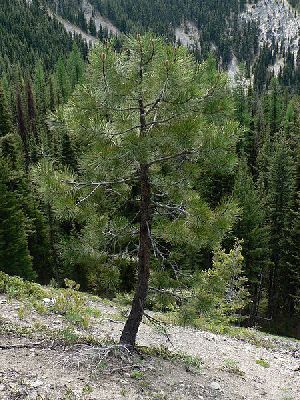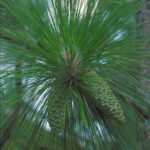The state tree of Montana is the Ponderosa Pine (Pinus ponderosa). This tree is also known as Pacific ponderosa pine, western yellow pine, yellow pine, pino real pine, pinabete pine, bull pine, black Jack pine, western red pine, western pitch pine, big pine, heavy pine, Sierra brownbark pine, western longleaf, and ponderosa white pine. At maturity, the ponderosa pine can reach 130 feet in height and 4 1/2 feet in diameter. Some trees are known to be 600 years old. The trunk tends to straight, and the trees are self pruning of the lower branches. Ponderosa pine is hardy in Zones 3 to 7, making it a desirable tree for many forest locations.
Ponderosa pine reproduces via seeds and is monoecious. The pine needles can be up to 10 inches long and smell like turpentine with crushed. The tree can be propagated by rooting and grafting. The tree is ideal for areas with shorter growing seasons and can tolerate some drought and salt conditions. In the wild, tree stands are common in dry areas with adequate warmth from the sun and tend to grow better when there is no ground-level vegetation that competes for soil nutrients.
Ponderosa pine grows on a wide range of soils including wet clay loams, sand and gravel, and coarse clay. The prefered soil pH is between 6 and 7, but the trees can tolerate a range of 4.9 to 9.1.
Ponderosa pine is a commercially valued source of high grade lumber used in construction, molding, cabinets, and doors.
Many parts of the tree are food for local wildlife. The stems and roots are eaten by deer mice, chipmunks, shrews, voles and squirrels. Seedlings and lower branches are favored by elk, deer, rabbits, cattle and sheep. The seeds are a favorite of birds including junco, finch, pine siskin, grosbeak, thrush, sparrows, and chickadees.
The ponderosa pine is also home to nesting birds such as pigeons, hawks, owls, woodpeckers, and chickadees. Dead trees that have fallen provide shelter for both rodents and reptiles.
Historically, the early people used the tree sap as a skin salve that was said to be beneficial for relieving aches and also made a food product from the cambium (which also is the source of the growth ring).
There are four generally accepted species of ponderosa pine: P. ponderosa subsp. ponderosa, P. ponderosa subsp. benthamiana, P. ponderosa subsp. brachyptera, (or Pinus arizonica), and Pinus ponderosa subsp. scopulorum. The trees are known to be very resistant to fires. In earlier times, the fires would consume the oaks, ground litter, and other pines, leaving the ponderosa pine intact. With modern forest fire prevention efforts, the competing trees are crowding the ponderosa pines, and forest fires are more intense and therefore more destructive. There is ongoing discussion in managed pine forests to reintroduce the low-intensity burns.
The ponderosa pine has predators. Insect damage can destroy seeds and deform the seedlings. Butterflies and moths can strip trees of pine needles. The pines are also susceptible to parasites, root diseases, rusts, and blight.
Sources
Pinus ponderosa, US Forest Service, http://www.fs.fed.us/database/feis/plants/tree/pinponp/all.html
Pinus ponderosa, The Gymnosperm Database, http://www.conifers.org/pi/pin/ponderosa.htm
Pinus ponderosa, Virginia Tech, http://www.cnr.vt.edu/DENDRO/DENDROLOGY/syllabus/factsheet.cfm?ID=108
Pinus ponderosa, North Carolina State University, http://www.ces.ncsu.edu/depts/hort/consumer/factsheets/trees-new/pinus_ponderosa.html






